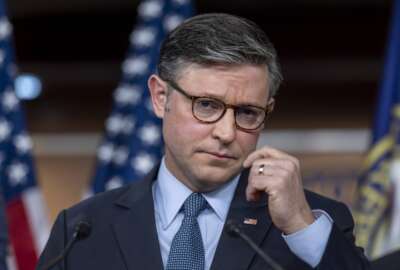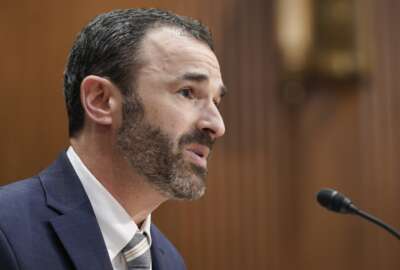DoD struggles to explain JFCOM closing
Some Senate Armed Services Committee members are unhappy with the Pentagon\'s lack of transparency and inclusion in the decision to close the base. Defense Deputy...
wfedstaff | June 3, 2015 2:35 pm
By Jason Miller
Executive Editor
Federal News Radio
Lawmakers are putting their support behind most of the Defense Department efficiency initiatives. The key word here, however, is “most.”
The Pentagon’s decision to close Joint Forces Command in Norfolk, Va., remains its biggest hot spot in its effort to save $100 billion over the next three years.
Defense Deputy Secretary William Lynn tried to explain the department’s rationale for its plans to reduce spending on contractors, consolidate offices where it has determined there is duplication and freeze current staff levels for specific positions.
“The effort not just about budget, it is also about operational agility,” Lynn said during the first of three hearings this week on DoD’s efficiency initiatives. “We need to ensure that the department is operating as efficiently and effectively as possible. The secretary has directed us to take a hard look at how the department is organized, staffed and operated. How we can flatten and streamline the organization, reduce executive and flag officer billets and the staff officer apparatus that supports them, shed overlapping commands and organizations and reduce the role and the cost of support contractors.”
But Lynn was unable to convince all the members of the Senate Armed Services Committee of their reasoning to close JFCOM.
“The core issue here is a disagreement over the recommendation,” he said. “This was not a business case analysis as some has described it. This was a military decision. The secretary consulted with his closest military advisors on the rationale for the Joint Forces Command.”
Defense Secretary Robert Gates held about 30 meetings with combatant commanders, senior military officials and other DoD experts over the last few months. Gates concluded that JFCOM was no longer needed as many of its functions were duplicative.
Lynn said Gates decided that DoD could no longer justify a four-start command with a $1 billion budget.
“There are four central purposes in the unified command plan having to do with joint manning, joint training, joint doctrine and joint experimentation,” Lynn said. “On the joint manning area, the conclusion is it was duplicative, it was not a value added function and that function was better performed at the joint staff. At the joint training and joint doctrine, those are purposes that continue and we need to maintain our progress on that, but we have made sufficient progress in that area, but we no longer need the billion dollar expense and the continued leadership of a four-star military command in that area.”
Lynn added that DoD will review the implementation of that decision to determine how much money DoD can save, and how much still is needed to maintain the joint training and joint doctrine facilities.
Sen. Jim Webb (D-Va.) was the most outspoken of the committee members against DoD’s decision.
Webb said he is more unhappy with how DoD went about telling him and the committee about their decision than the decision to close JFCOM itself.
He said Lynn called him 15 minutes before the public found out about DoD’s plans.
“Any proposal relating major changes affecting unified combatant commands should be guided by a clear process, a sound analytical basis and compliance with applicable laws in a way everyone can understand it,” Webb said. “This is not a parochial issue. It is an issue that will become more important to everyone on this committee as Secretary Gates and others follow through on their stated intention to consolidate other military bases and installations. The present lack of transparency and consultation stands in stark contrast to how these decisions traditionally are made.”
Webb said the committee didn’t have access or an opportunity to provide input.
“This is not the way to conduct a review that has enormous implications to our defense and to community interests,” he said. “I believe in another sport it’s called stiff-arming.”
Webb introduced an amendment to the DoD authorization bill that would require the Defense secretary to provide Congress with information before closing any combatant command, not just JFCOM. Webb also is renewing his call to President Obama to withhold any action before Congress has full and complete information from DoD on their decision.
Sens. Carl Levin (D-Mich.) and Joseph Lieberman (I-Conn.) also were slow to express support. Both senior senators say they will withhold their decision until they receive more information on how DoD decided to close JFCOM.
“We need a detailed accounting of the functions performed by the organizations that the Secretary proposes to consolidate or eliminate,” Levin said. “For those functions that will no longer be performed, we need to understand why they are no longer needed. For those functions that are still needed, we need to understand who will perform them. We need to understand what will be transferred, what resources will be eliminated and what the real savings are likely to be.”
Levin said this doesn’t just apply to JFCOM, but the Assistant Secretary of Defense for Networks Information and Integration (ASD/NII), commonly known as the chief information officer’s office, and the Business Transformation Agency (BTA).
Gates determined that these three organizations would either close or a majority of their functions be shifted to other organizations.
In fact, Lynn issued a memo detailing the changes to the CIO’s office. The Air Force Times first reported that the memo calls for the functions of the ASD/NII be moved to four different elements-the DoD Cyber Command, the Defense Information Systems Agency, the Undersecretary of Acquisition, Technology and Logistics and the comptroller’s office-by March 31.
“We will retain the CIO,” Lynn said. “That individual will be a direct report to the Secretary of Defense. So in terms of the level, you will still have that direct report that the NII has now. We think with the steps we are taking we will give that CIO greater resources. We will pull in the resources from the joint staff J6 directorate, from DISA and potentially some functions from other areas to unify the IT oversight in the department. We think we will end up with a stronger CIO.”
Lynn didn’t offer any further comment on the status his plans for the DoD CIO, nor did he say anything about Teri Takai, the nominee.
Sources say Takai could be in place within a matter of weeks because she doesn’t need to be confirmed since she will no longer be an assistant secretary of Defense.
As for the BTA, Lynn said the deputy chief management officer would assume most of its duties. He said the deputy CMO and BTA’s responsibilities overlap and DoD believes cost savings are highly possible by reducing staff and closing BTA.
Sen. John McCain (R-Ariz.) was one of the few committee members to support both the closing of JFCOM, and most of the other DoD decisions.
He did however express concern about DoD’s troubles with ensuring competition for contracting. He said the shrinking Defense industrial base is among the biggest challenges the military faces in getting competition.
Ashton Carter, DoD’s undersecretary for Acquisition, Technology and Logistics, said about $55 billion of $400 billion in acquisition spending in 2009 received only one bid-mostly from the incumbent.
He told McCain and the committee that DoD is committed to ensuring better competition in part by tying profit to performance for vendors, testing a preferred supplier program and changing how the Pentagon evaluates bids such as using the downselect model.
“This has shown to reduce single bids by 50 percent, promote competition and drive productivity growth,” he said.
(Copyright 2010 by FederalNewsRadio.com. All Rights Reserved.)
Copyright © 2025 Federal News Network. All rights reserved. This website is not intended for users located within the European Economic Area.





